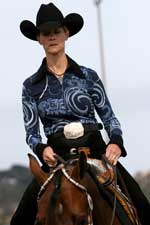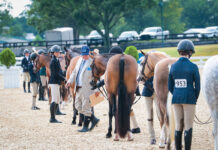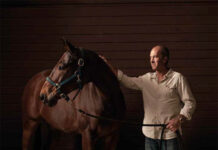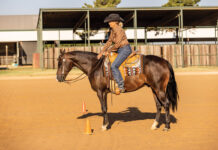 |
Two and a half minutes doesn’t sound like a long time, but it sure can feel like it. Two and a half minutes is about as long as it takes to ride a reining pattern or a hunter equitation course. Try this: For the next two and a half minutes, try holding your breath.
Still having trouble getting through? It’s amazing, then, that so many riders can subconsciously hold their breath while riding. Does that sound like something you’ve experienced? Most riders have subconsciously held their breath at some point in their riding lives, and those who haven’t certainly know someone who has. For such a natural human function, breathing effectively while riding can be surprisingly difficult.
Call it nerves, fear of the unknown, performance anxiety, or lack of confidence. Whatever you call it, anxiety is the No. 1 cause of riders holding their breath.
Bill Black, Mary Wanless, Karen Healey and Shawn Flarida—trainers from a variety of disciplines—have all had students who held their breath or did not breathe effectively. Here is their advice for better breathing and the better riding that will follow.
Changes in Your Body
It’s basic human science: Breathing brings oxygen into the body to be distributed to your muscles and brain. If your breathing stops or becomes shallow, so does your oxygen supply. Without oxygen, neither your muscles nor your brain can function well. This decrease in muscle and brain utility creates changes in your body that, in turn, affect your horse.
“Holding your breath creates tension to start with. Then it creates weakness, and it also creates a lack of focus that affects your decision-making abilities,” says Bill Black, an American Ranch Horse Association judge and 2005 ARHA World Champion in ranch roping.
Tension in the rider makes the horse brace, Black says. “Because you’re tense, the horse is tense. He’s not assured by your presence. It doesn’t mean a highly trained horse won’t perform with a rider who’s tense; it means the horse won’t perform to the level that he is capable of.”
A tense horse and a weak rider are never a good combination, whether or not the horse is well trained. “The rider has become the victim. There is no way for the rider to be causal; the rider is only reactive to what the horse does,” says Mary Wanless, teacher and author of numerous books, including The Natural Rider and Ride with Your Mind Essentials. Being proactive, not reactive, is the basis of riding well. You aren’t communicating effectively when you’re simply reacting. In this situation, your horse is directing you, rather than you directing him.
Top hunter equitation trainer Karen Healey, whose students have won more than 60 medal finals, including the ASPCA-Maclay National Finals and the United States Equestrian Team Talent Search Finals, explains, “You have to be able to stay in tune to ‘read’ your horse. You have to be able to feel what’s going on underneath.”
Mary Wanless adds, “There’s a great concept that actually comes from [motivational coach] Timothy Gallwey about your comfort zone, your stretch zone and your panic zone. The person who has stopped breathing will be in the panic zone. Once you are in the panic zone, you’re not processing mentally anymore. So the lights may be on, but nobody is at home. You’re frozen, basically.”
It’s a vicious cycle. The rider tenses up about having the perfect ride. Then the horse becomes tense because the rider is tense. Now the rider is subconsciously holding his or her breath, has completely lost focus, and has let the horse take over. The “perfect ride” quickly turns to disaster for this out-of-breath rider and out-of-control horse.
The Cure
People, like horses, each have a different manner of approaching a problem. The breathing problem cure-all for one rider might not work for you. These 10 tips for dealing with ineffective breathing can be applied to any riding situation, whether facing a course of jumps, a dressage test, a reining pattern, or a day of basic horsemanship.
Develop a rhythm. “In through the nose and out through the mouth. Relax,” Bill Black says. “Gulping and gasping for breath won’t cut it, especially in competition.”
To find a rhythm, Mary Wanless suggests breathing in time with your horse’s gait. “In walk, count four legs. You want to count ‘in-two-three-four, out-two-three-four.’ That’s actually in for two strides and out for two strides. And if you can do six, that’s better. For example, in rising trot, you need to be able to breathe in for at least three sits, and breathe out for at least three sits. If you can’t do three sits, then you’re pretty compromised in your breathing.”
Think it through. “Break up the course into parts,” Karen Healey advises. “Most are nothing more than a series of gymnastics. You isolate them, define the problem, recognize the solution to the problem, and then go on to the next problem. Don’t worry about the next problem before you solve the one you are about to enter into.”
Believe in yourself. “Sometimes people go in [the arena] and get so scared,” Shawn Flarida says. He encourages his riders to be calm and unafraid by building their confidence and teaching them to believe in themselves. “I try to get them to be confident in what they’re doing,” Shawn says. “Hopefully they’ll start trusting themselves, and things will fall into place, and they’ll just respond to what’s happening.” Based in Springfield, Ohio, Shawn has captured many of the most coveted titles in the world of reining. Among them, he holds team and individual World Equestrian Games reining gold medals.
Plan your breaks. Karen Healey looks at riders holding their breath as the equivalent of getting on a “hamster wheel.” Holding their breath and the mental meltdown that accompanies it means the hamster wheel goes faster and faster. To get off the wheel, Karen encourages riders to take breathing and mental regrouping into account when walking and studying their jumping course. When studying your course, think, “This is where I breathe.” “Specifically,” Karen says, “write it down; don’t just say it. Later on, you can say it and think it, but in the beginning, write it. You actually incorporate that into your analysis of the course.” These planned breaks help riders visualize where they will breathe, relax, and slow the wheel down before they even go into the ring.
Take the pressure off yourself. “You very seldom ever see [breathing problems] in young people or children,” Shawn Flarida says. “The kids just go; they don’t realize anybody’s watching; they don’t realize there’s any pressure; they don’t realize what’s at stake. As adults, I think that’s when we get, so-called, ‘screwed up.’ ”
Practice, prepare and practice some more. “I see so many people that just go in there [in competitions], and they do things that are out of character; maybe they take the wrong lead departure. A lot of that is lack of confidence or lack of focus, like they’re not breathing or relaxing. Preparation makes a lot of that stuff go away,” Shawn says. If the problem is really bad, he advises getting some paid warm-ups with a coach telling you exactly what to do during every stride.
Don’t just breathe; breathe deeply. Mary Wanless has developed a breathing system of diaphragmatic breathing coupled with a technique she calls “bearing down.” Diaphragmatic breathing is using your diaphragm muscle to breathe into the whole of both of your lungs, rather than just the upper part of the lungs, which all people, not just riders, tend to do.
While discussing bearing down would encompass an entire article, Mary emphasizes, “Diaphragmatic breathing is the same breathing pattern you would learn if you were to sing or play a wind instrument. This is the most efficient breathing pattern. Oxygen exchange is much more efficient if it takes place in the bottom third of the lungs.”
Don’t smoke. “Don’t impair your breathing. Oxygen is the stuff of life,” Bill Black says.
Develop a breathing habit. Mary Wanless says, “One key thing is people will not breathe one way 23 hours a day and get on their horses and breathe differently on hour 24. You have to learn to breathe like this as a way of life.”
Monitor yourself. Don’t rely on your trainer to point out when you aren’t breathing properly. “A question I use a lot to riders is, ‘When you breathe in, how far down does the breath go?’ You’re trying to get it really far down in your abdomen,” Mary says.
To sum it up with perhaps the best breathing tip of all, Bill Black says, “ride more, become aware and relax. Simplify things.”
Breathing properly while we ride doesn’t have to be difficult. All riders—breath-holders and diaphragmatic-breathers alike—can benefit from the techniques presented above. Try some, and notice the difference in your ride.
Lisa Munniksma, a writer from Frankfort, Ind., has more than a dozen years of experience in holding her breath while riding at home and in various competitions, and is on a quest to break this habit.







Thanks for the acticle. I tensed up yesterday riding and the ride was horrible. Lopeing was a disaster. I was so nervious for my 1st show of the season on Sunday. Now i know what to do.
Thanks for this article. I have developed a habit of holding my breath, but for the past two riding lessons I have begun to incorporate a habit of breathing into my riding and trying to make it better. And I always know why I held my breath. It is because I get nervous and scared, worried about the outcome of my ride with the horse, I get anxiety about doing certain things wrong or things going horribly wrong. But when I take the time to concentrate on my breathing from now on it helps me. I ride English but this is for anyone. And I think it’s really important. Because it’s true. When you hold your breath, then you tense up and the entire riding dynamic between you and your horse changes and I found that I couldn’t think straight when I was holding my breath. Luckily I can practice more and I thank you for these helpful tips that I know and am positive will improve my riding for the better. It’s greatly appreciated and I hope that Horsechannel.com loads up on a lot more articles about basic riding on these topics at it is so important because a lot of people tend to miss out on important basic riding skills that can really improve our riding with our horse. Thanks so much and I hope to see more of these articles! =)
I guess…I know…I am guility of holding my breathe.